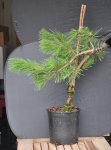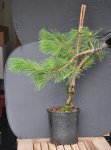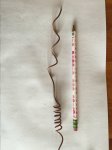Well, this thread has pretty much been hijacked already ...
Sorry, but this is not what happened. It behaved nothing like you imagine and nothing like my other experiences with JBP.
This tree is was about 4 feet tall and in a 1 gallon pot when I bought at a local garden center for $10. I can only speculate about its history at the grower.
View attachment 115176
Aside from a try out for the silicone tape, my plan was to bend this around on itself and secure it with guys. The heavy copper wire was applied for compression, not to hold the bend.
I simply gripped the trunk with my fingers and started trying to bend it - snap! Moved up the stem a bit farther and tried again, a bit more gingerly - snap! Here it is afterward (I'm sure you will notice that I also up-potted it before 'bending') - so now it should be clear just what I was up to.
View attachment 115177evergreengardenworks.com is one such place.
Would like to explain why the bend failed...
I again, am not trying to attack you here, just trying to help you learn, so hopefully you will have better luck next go around!
In this particular case, sadly it is the wire that caused the problem, and led to the breaks... and might very well of happened regardless of what you are using for binding.
I will explain...
The idea if using wire to help with compression, has it's advantages, as well it's disadvantages... When you apply wire, not only are you having to bend the branch, or in this case the trunk, but you are also having to bend the wire as well. The heavier the guage... the more pressure you will have to apply.
Now, in theory it sounds logical that the more wraps one does and the tighter the coiling, the better compression and support you are offering the branch to bend with, and the more protection you are offering to prevent a blow out... And you are... But, where the problem lies, is that this protection is only as good as it's weakest link. So, in this case... where there is no wire. Only way you could prevent, not having any spacing, would be to literally coil the wire right next to the last coil and make a solid structure. However, this would be quite literally impossible to bend. This why instead we use Raffia or binding... it is intended to do this job, and wirh a most no resistance.
So, seeing that when you add wire to bend, you also have to take into consideration the amount of force it takes to not only bend the trunk, but the wire itself... as well, that you have doubled pretty much the coiling. Which now means it will take twice the force to do the bend. In essence, you have actually hindered the bend, even though your intentions were sound. The amount of force needed to bend the wire was greater than the trunk could withstand. And the breaks occurred, where there was no wire to help support the trunk.
Again, I am only saying this to try and help. Not trying to knock you... and in fact I want you to succeed at this!
So, first off...
When doing a bend, examine and figure out the "Grain" of the area being bent. If you take a 2X4 piece if wood and examine it... you will see the grain of the wood runs along it's length. If you lay it flat on an object, on its 4 inch side, with only it's center supported... over time you will find the the ends on either side will sag. This is due to the fact that the grain runs along this direction, and the bend that is created due to the sag, also runs along the grain and the wood is less structurally sound.
Now if you were to take the same board and lay it on a object, only supporting it's center, but you turned the board, where it rested on it's 2 inch side... over time you will find virtually no sag. This is why in construction of buildings boards for joists are placed this way. They are more structurally sound this way, and in order for them to sag, they would have to bend across the grain.
Very important to understand in doing bends in Bonsai! If you take your hand and bend an area where you would like to preform a bend, you will see that if you bend in one direction, there is hardly any resistance, where if you try to bend in the other it is virtually impossible. So, always plan bends with this in mind. Success will always be greater bending with the grain.
Now, what you can do, and where wraping wiring helps... is that it will allow you to twist the trunk or branch during a bend, to position the direction of the grain, for another bend along the grain further out. This is why often times you will see when some one bends, they will often add a twist in as well.
So, to go back to your tree...
The very first bend you did in your image, was just down to the right. This cut across the grain, thus the break... What I would have done differently would of first, started the bend towards the back, then add a twist as I did so, and brought the branch back down and towards the front.
In essence, creating a curved bend down, not straight. Think of a mountain road here... gradual curved descent, puts a lot less wear on your brakes than a straight down hill shot. It puts less stress on the area being bent as well.
With this bend and curve introduced, you would set yourself up for the next bend. the grain, would now run along the length of the branch, and you could do a bend straight down.
So, in hindsight...
The bend you were trying to perform, the way you did it... would have been actually more successful without wire at all. Just "Raffia", bound tight, and using a guy wire.
However, to of alleviated any possibility of stress, and possible break, I would of wrapped wire properly, wirh correct spacing, and done the bend backwards as I have suggested, with the twist introduced during the process. Making sure that the wire I had wrapped, was coiled on the direction of how I wanted to do the twist... if not, it will just un-coil itself, and would make sure that and areas bent, we're done in an area, where there was support from the wire behind, to give compression to the outside of the curve, to prevent a blow out.
Just, takes practice and constant doing!
Keep it up... you will get there!





